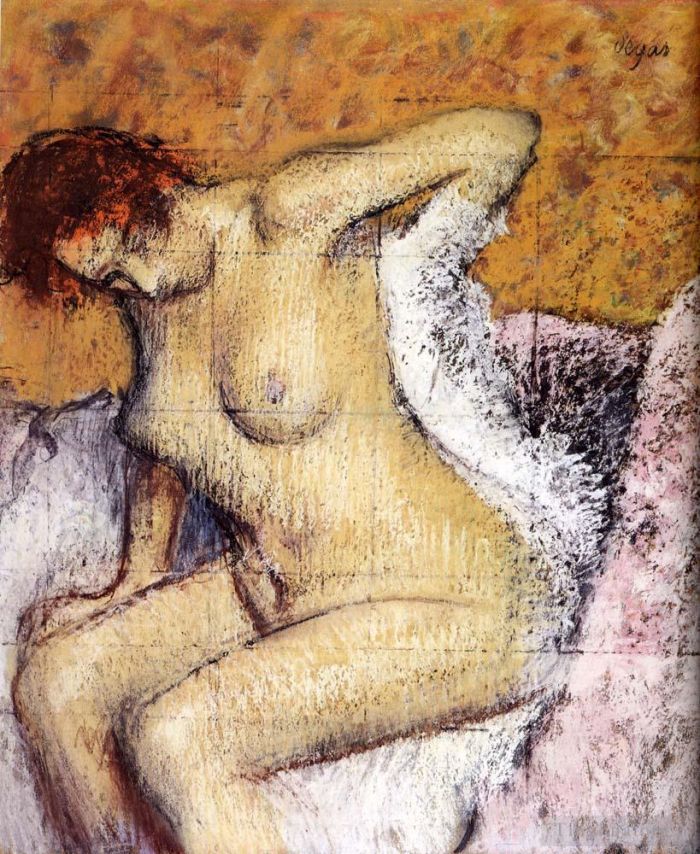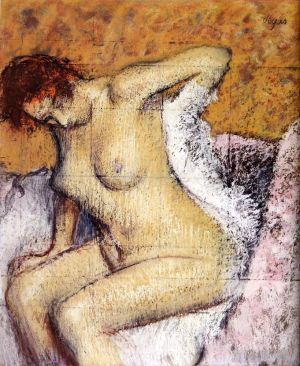After The Bath
Edgar Degas
- Price: Price on Request
- Art Type: Various Paintings
- Size:
- English Comments: 0
- International Comments: 0
- Creating Date:
- Introduction and Works of Edgar Degas >>
Keywords:
Bath
Work Overview
- After The Bath
Edgar Degas
Date: 1895
Style: Impressionism
Genre: nude painting (nu)
Until 1865, when Scene of War in the Middle Ages, was presented at the Salon, Degas wanted to be a history painter in the tradition of the "grand genre", which took events from history, the Bible or Greek and Roman mythology as subjects.
This desire explains his study of many different poses, each a potential element to integrate into the final composition.
In Scene of War in the Middle Ages, , the event described by Degas remains uncertain: for a long time it was thought to be a transposition into the past of an allegorical scene – not a drop of blood is spilled – of the violence suffered by the women of New Orleans during the American Civil War.
Although Degas might well have known of these atrocities through his maternal family who lived there, his work is above all an illustration of the brutality and inhumanity of men towards women in times of war.
His last history painting, Scene of War in the Middle Ages, whose matt appearance pays tribute to the fresco painters of the 15th century, marks a turning point in Degas' work.
The final work and the collection of preparatory drawings that accompanies it, reveal both the assimilation of many different sources of inspiration, including Goya, Delacroix and Puvis de Chavannnes, and a new focus on the body, that he subsequently developed in his contemporary studies of women bathing. In fact he picked up the same poses with the same unsparing observation but in a completely different context, and with the same unsparing observation. The transition towards Realism is particularly striking in his studies for Interior, also called The Rape, his most important genre painting, created at the end of the 1860s.
- Copyright Statement:
All the reproduction of any forms about this work unauthorized by Singing Palette including images, texts and so on will be deemed to be violating the Copyright Laws.
To cite this webpage, please link back here.
- >> English Comments
- >> Chinese Comments
- >> French Comments
- >> German Comments
- >>Report
- The Dance Class
- Portrait of the Painter Henri Michel Levy
- The Rehearsal
- The Rape
- Edmond and Therese Morbilli
- Before the Race2
- Ballet Rehearsal
- At the Milliner s
- Singer with a glove (Café Singer)
- Head of a Young Woman
- At the Races Before the Start
- Four Dancers
- At the Milliners 2
- The Ballet Class
- The Star
- Woman Ironing 1884
- At the Races in the Countryside (A Carriage at the Races)
- Portrait after a Costume Ball Portrait of Madame DietzMonnin
- Beach Scene
- A Roman Beggar Woman
- A Carriage at the Races
- Degas in a Green Jacket
- Henri De Gas and His Neice Lucie Degas
- Dancer At The Photographers
- Ballerina and Lady with a Fan
- Self Portrait
- At the Races the Start
- At the Milliners
- Achille De Gas in the Uniform of a Cadet
- The Millinery Shop
- Interior aka The Rape
- In a Café (Glass of Absinthe or The Absinthe Drinker)
- Diego Martelli
- Cotton exchange
- Ballet at the Paris Opera
- Edmond Duranty
- The Star (Ballet or Dancer on Stage)
- Hortense Valpin
- The Dancing Class
- Dancers in Pink
- The Bellelli Family (Family Portrait)
- At the Milliners 3
- At the Races
- Cafe concert
- Portrait of Mary Cassatt
- The Parade (Race Horses in front of the Tribunes)
- Woman ironing
- Ballet Class
- Emma Dobigny
- CAFÉ CONCERT AT LES AMBASSADEURS
- The Duke and Duchess Morbilli
- The Rehearsal of the Ballet Onstage
- Dancer at the Barre circa 1880
- At the Mirror
- After the Bath
- Study of Gentile bellini 1854
- After the Bath
- Before the Rehearsal 1880
- After The Bath
- The Tub
- After The Bath 1884
- Woman Combing Her Hair
- At the Ballet
- The Dance Examination
- Woman At Her Toilet
- After the Bath Woman Drying Herself
- Seated Dancer Adjusting Her Shoes









 Singing Palette
Singing Palette